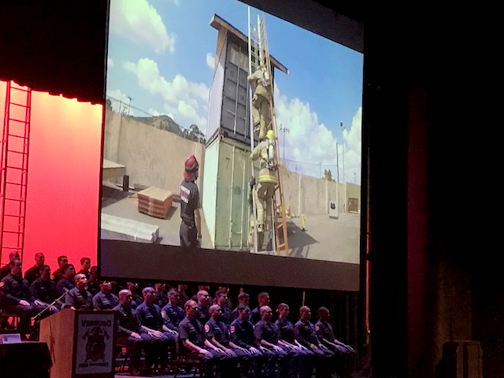After months of intense work, these cadets conquered fears, challenges and struggles to graduate with Class XX.

During graduation, family and friends of the cadets were shown examples of the training that the cadets completed.
By Mary O’KEEFE
On Sunday, 28 members of the Verdugo Fire Academy Class XX graduated after 12 months of classes. These included 900 hours of instruction in areas including firefighting survival, aerial ladder, live fire, ventilation, ladders and vehicle extraction. They came into the Academy as individuals but left as a team.
Verdugo Fire Academy is based out of Glendale Community College with its main sponsor being the Glendale Fire Dept., although the Academy does receive support from the departments within Verdugo Fire Dispatch (Communications Center).
“Many times those [sponsored students] started out as Explorers,” said Fire Chief Sam DiGiovanna of the VFA.
He added most fire departments require that job candidates have a state certification as a Firefighter 1. The program created by the National Fire Protection Association sets minimum standards for firefighting training for the state.
For the students, though, it is the instruction and learning how to work as a unit that are the important lessons learned.
“It would be an extremely long year if we did not work together and become one,” said James Ramlochan, class battalion chief, of what he learned on the first day of the academy.
Cadet David Markheim also shared his thoughts of his first day.
“I stood there for what felt like an eternity and I thought, ‘What did you get yourself into?’” he said.
He said that on the first day all the cadets looked around and “sized” each other up, to see who would make it and who would not, and throughout the year it was the camaraderie that grew.
“We came together as a team,” he said, but then added, “not as a team but as a family.”
He said they found they all had what it took to make it through the Academy.
Cadet Giselle Mendieta echoed that feeling of family.
“I remember the first day at the Academy like it was yesterday. My heart was pounding; it felt like it was beating out of my chest,” she said.
She said she learned a lot of lessons during the 12 months of training, including to always pay attention to details and that you have to fail to gain wisdom.
“We faced many fears, challenges and struggles that we overcame,” she said.
She shared one of her struggles during the class.
“We had to take the ladder off the engine,” she said.
To some, this may seem like an easy task, but for her it was a challenge.
“It was quite difficult for me. Maybe if I was taller or had longer arms,” she said.
But those, she added, were only excuses she thought. In the end, she was able to overcome the difficult task.
“I found it’s not the size of the person, but the size of the heart [that matters],” Mendieta said.
All the cadets thanked their families and friends for their continued support throughout the class. While attending the Academy, many of them continued to work full time or were full time students. Their support system helped them see it through.
The instructors at the VFA are retired and active firefighters who share their real life experiences. They are tough on the cadets because they know how tough their job will be once they’re hired as firefighters.
After they graduate they are encouraged to apply to fire departments that are hiring and to continue their education through reserve programs, DiGiovanna said.
“It is very competitive,” he said of the fire department hiring opportunities.
He added that many current firefighters are from the baby boomer generation and will be looking to retire.
“I think there will be more openings than there ever has been in the past 30 years, but it is still very competitive,” he said.
VFA does not guarantee that cadets will get a job; however, it gives them an advantage because of the certification they earned that is required by many fire agencies. In addition, each of the cadets must be trained as an EMT [Emergency Medical Technician]. VFA is also always improving its curriculum as new advances are made and new training required.
“Look at how the world is changing,” DiGiovanna said. “There are so many different dynamics.”
DiGiovanna added that when he began his career the concentration was on fire and medical services, but now there are so many more issues that firefighters respond to, including natural and manmade disasters.
The VFA program has strong support from the Glendale Fire Dept., the City of Glendale and everyone from GCC including District Superintendent/President Dr. David Viar.
“And I could not be more proud of the instructors at VFA,” he added.
Many of the instructors were out fighting the numerous wildfires throughout Southern California during the end of the last VFA semester. DiGiovanna said he was worried because so many instructors were gone; however, all worked together to complete the cadets’ year.
The Verdugo Fire Academy was established in 1979 by Glendale, Burbank and Pasadena. They were facing similar issues of the time including limited local resources, voluntary mutual aid with an average 45-minute delay, unfamiliarity with neighboring cities’ geography, nonstandard firefighting tactics and incompatible equipment, and a lack of common radio frequencies, according to Verdugo Fire History.
The departments realized they needed cohesive training that included communication. The program expanded to include South Pasadena, San Marino, Monrovia, Arcadia, Sierra Madre, San Gabriel, Monterey Park, Alhambra, Montebello and Burbank-Glendale-Pasadena Airport Authority.
These city fire departments support the VFA and, in some cases, support the students through sponsorship. For example, if a student is sponsored by the Pasadena Fire Dept., that agency helps the student with the costs of equipment, which is required for the class, like gloves, helmet and safety gear.



